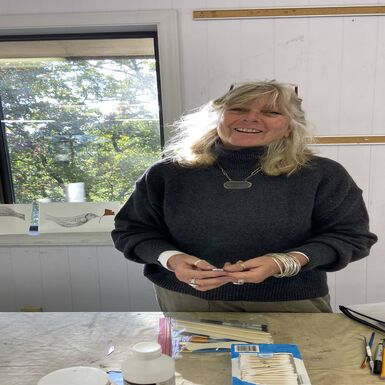Join us and learn printmaking methods that you can use on your own at home- easily and with no expensive materials or tools. These techniques prove to be a great tool for your artistic tool box, as well as providing opportunities for very family-friendly art experiences!
Part One:
The Playful Brayer
The technique of printing fresh botanicals utilizes a common printmaking tool, a brayer, usually employed to spread or apply ink for printing. In this case, we will use the brayer as a press of sorts, which results in a very painterly approach in comparison to most printmaking methods. It’s a great way to produce multiple prints, each one completely different from the last and it is a beginner-friendly process, easy for children and adults alike. We will spend time learning the basics of one-color printing, mixing custom colors and will use multiple color images for more dramatic effect. This is a great way to make cards and items such as notebooks and stationery. It is very effective for collage work but also strong enough to stand alone in a frame.
Part Two:
Gelli Plate Explorations
Gelatin plates, first developed in the 1800’s, have been used by printmakers for years but were cumbersome, having to be made by the artist and so not readily available if the mood struck. Enter two female artists, who offered the first commercially synthetic version of a gel plate in 2011 and founded GelliArts. The idea was sheer genius, combining soft-edged results with the ease and convenience of the modern world. There are so many options with a Gelli Plate-it could take a full week of classes to cover them! We will explore the basics, starting with stencils, masks and dried- pressed botanicals. You will experiment and explore what you can and cannot do with these monotype plates. At the end of the day, we will discuss what you can do with all of the prints you create during class, including but not limited to: framing, cardmaking, collaging, incorporating the work in your book binding efforts, and more!
Part Three:
Color Extraction Printing
Commercial fabrics are often overdyed, meaning more than one dye bath is employed to reach a one-color result. Using color extraction methods, we can reveal the underlying colors to create depth and layers to the surface of the fabric or paper. We will work primarily with fresh botanicals and found objects to create interesting surface design patterns, primarily on fabric and some paper. We will use masks and stencils to create explore patterning the surface of fabric and paper to take the plain and simple color to the next level. If you are a seamstress you could actually plan your final garment and use this technique to create a unique and amazingly beautiful piece of wearable art. Or you can use your work in many other ways.
For questions or assistance please contact Elizabeth Buccino, Director of Education
All materials included in tuition.
